Abstract
The study of human behaviour has been cementing its place within economics for decades. The complexity of decisions in family farming, challenging agricultural markets, and climate change have drawn attention to human behaviour, namely risk perceptions and the decision-making process, with a focus on agricultural economics. This paper reviews current knowledge on risk management in agriculture from the behavioral perspective, and from the perspective experimental economics in particular, emphasizing a discrete choice experiment approach. A discrete choice experiment (DCE) elicits stated preferences through hypothetical choices and have been extensively applied in research on risk preferences and farmers’ willingness to apply different risk management strategies. The objective of this paper was to determine the frequency at which papers are published and their use in discrete choice experiments in general and in agriculture and emphasizes risk management in agriculture using bibliometric analysis. The PRISMA framework was used for a systematic literature review of the agricultural risk management publications that apply a DCE. The main steps to achieve the aforementioned goals are to define how many publications are primary research versus theoretical publications in the research area of agricultural risk management, which part of risk management in agriculture it covers, and how many attributes were used in each study. The authors reviewed 20 papers based on the following keyword criteria: discrete choice experiment, agriculture, risk management, and the period 2001–2021, using the Web of Science database. The results show an increase in DCE publications over the past 20 years. A comprehensive literature review of risk management in agriculture concluded that publications are primarily research focused, mainly consider on-farm strategies and smaller-scale risk-transfer strategies, and are predominantly conducted among farmers. The average number of attributes per publication is four to five. Limitations and directions for future research are discussed in the paper.
1. Introduction
Experimental economics is a branch of economics used to study the interactions between people in social settings that are governed by certain rules [1,2]. For example, through experiments, policymakers can test the effects of the proposed policies and actions before implementation [2]. In the agricultural sector, experimental economics has become increasingly important in the last twenty years [2].
The reason for more development in the experimental economics research area can be attributed to increasing exposure to market turbulence, climate change, and increasing environmental problems. Environmental issues are important and related to biodiversity loss, rising temperatures, soil erosion, and pollution. To cope with the aforementioned problems, environmental policies, which are becoming increasingly informed by behavioural economics insights, can be used [3]. These trends switch from linear to bioeconomic and include choosing renewable energy sources, saving energy, or using innovative farming practices, which are known as “green nudges” [3]. Nudge theory generally refers to “a concept in behavioral economics, political theory, and behavioral sciences that proposes positive reinforcement and indirect suggestions as ways to influence the behavior and decision-making of groups or individuals” [4]. In order to research farmers’ readiness to adapt to new and innovative farming practices, systems or strategies from different economic experiments can be applied.
Economic experiments represent real or hypothetical situations in which respondent behaviours are researched and different theories are tested. In experimental cases, the researcher conducts an experiment among respondents, who may be farmers, policymakers, or consumers in the case of agriculture and the food sector. Experiments help to elicit revealed and stated preferences. Different approaches can be used for researching revealed preferences, such as monetary-incentivized games or games with real outcomes, for which various methods can be applied [5]. In hypothetical situations, when we elicit our stated preferences, a discrete choice experiment (DCE) can be used [5]. A DCE represents one of many experimental economic approaches. The discrete choice experiment approach is becoming increasingly important and applicable in the scientific community, and it has been used in health economics, water, transport, tourism, and agriculture studies [6].
DCE design involves different steps that define the research problem and the appropriate alternatives, attributes, and associated levels [6]. After the alternatives, attributes, and levels have been designed, the choice sets need to be defined. Before conducting research, the final DCE design most often requires a pre-test and, after collecting the necessary data, a DCE analysis [6].
As a quantitative method, a discrete choice experiment presents the respondent with several alternatives from which they choose the one that maximizes their utility. As mentioned above, every alternative is defined with appropriate characteristics, known as attributes and levels. Alternatives mainly involve choosing from different (agricultural) products or (agricultural) productions, strategies, agricultural policies, agricultural measures, insurance types, etc. [7]. DCE helps us to understand how respondents value selected attributes and their importance [6]. DCE is a base for further research; for example, DCE can help to research the willingness to pay (WTP) for every attribute and express it in monetary value.
Risk management is, or should be, an integral part of management for multinational companies, government institutions, agricultural enterprises, or smallholder farmers [8]. Risk management reduces, transfers, avoids, eliminates, and exploits risk and enables a more successful and profitable (agri)business [8]. The Common Agricultural Policy (CAP) in the European Union promotes the importance of risk management through the introduction of a risk management toolkit during the new programming period. CAP risk management measures are subsidized by agricultural insurance, mutual funds, and income stabilization tools. Previous research on risk management in agriculture mostly elicited farmers’ perceptions of risks and risk management strategies [9,10,11,12,13]. On-farm strategies for farmers include the diversification of production and sources of income, production technology, consulting, information, knowledge, infrastructure, stocks, flexibility, variety selection, planting time, market channels, storage, and participation in the associations; flexibility and market information systems in agriculture; occupational safety measures; cash stocks; and cash flow planning. Risk transfer strategies include agricultural insurance, life or liability insurance, compensation for natural disasters, hedging, contract production, and lending [8]. Publications that use experimental approaches for implementing risk management strategies in agriculture are insufficient. The advantage of DCE in agricultural risk management is that it allows researchers to explore what farmers/(agri)business owners choose among different options (e.g., policies, measures, strategies, production technologies) and how they maximize their utility [6]. Through researching stated preferences, DCE helps us to understand the demand for products/policies/strategies in situations where it is impossible to use revealed preference data. Testing products/policies/measures before implementation helps to minimize unnecessary costs and to compare experimental results with theoretical predictions cases considering policy or business. DCE can be implemented to research farmers’ choices and behaviour in different settings, and the results help in planning and decision-making. It assists policymakers at the local and international levels in introducing new policies or programs and companies in introducing new products or services to the market [6].
This review summarizes recent scientific research on discrete choice experiments to determine risk management in agriculture. Publications available on Web of Science (WoS) and Scopus published from 2001 to 2021 and that could categorized under the keywords discrete choice experiment, agriculture, and risk management were considered in this review.
The paper’s objective is to research the frequency at which papers on this topic are published as well as the frequency of use of the discrete choice experiment method. First, we will provide some primary data about the applicability of the DCE method in general and in agriculture. The emphasis of the review is on risk management in agriculture among researchers, countries, research areas, and journals.
Furthermore, the objective is to conduct a systematic literature review of the publications in the area of risk management in agriculture that apply the DCE approach. Questions asked to achieve the mentioned objective are:
- (i).
- How many publications are primary research according to theoretical publications?
- (ii).
- Which part of risk management in agriculture does the research cover—on-farm or risk transfer strategies?
- (iii).
- How many attributes were used in each study?
2. Materials and Methods
Two review methods were used in the paper:
- (a)
- Bibliometric analysis;
- (b)
- Systematic literature review [14].
Bibliometric analysis is a scientific method that is used for exploring and analyzing scientific data [14]. The growing trend of applying bibliometric analysis is visible in areas such as business, management, accounting, economics, econometrics, finance, and the social sciences. The advantage of the bibliometric analysis is that it can summarize large quantities of data when the scope of a review is broad.
Bibliometric analysis was used to review the data about the number of DCE research studies in general, the distribution of DCE research by research area, the distribution of DCE research in agriculture according to research area, the trends of DCE research in risk management in agriculture, and the number of papers according to the authors’ affiliation country, journal of publication, and main co-authors. Data were presented in graphs and tables and were exported from the Web of Science (WoS) database.
Furthermore, this bibliometric study aims to summarize and synthesize discrete choice experiment publications on risk management in agriculture (DCE-RMA) according to keywords and the authors/co-authors. Publicly available VOSviewer software was used to analyze and visualize the data and networks [15]. The figures produced by VOSviewer are defined by nodes that represent an author and keyword, and the size of the node indicates the occurrence of the author/keyword; the link between the nodes represents the co-occurrence between author/keyword; and the thickness of the link shows the occurrence of co-occurrences between author/keyword. Colour represents a thematic cluster [14].
A systematic literature review was used to summarize the main findings of existing literature on the specific research area (DCE-RMA) [14]. A systematic literature review is used when the dataset is small and can be managed by hand when the scope of the review is specific.
The PRISMA method was used for the systematic literature review [16,17]. PRISMA represents a tool for systematic reviews and meta-analyses. PRISMA flowcharts were used to describe the research steps.
The PRISMA flowchart contains three main steps:
- (a)
- Identification;
- (b)
- Screening;
- (c)
- Inclusion.
Identification represents the first step, where we defined the main keywords for the systematic review of papers studying risk management in agriculture using a discrete choice experiment. A literature review was carried out by screening the Web of Science (WoS) [18] and the Scopus databases [19]. The main keywords used in the database search were “discrete choice experiment”, “agriculture”, “risk management”, and “Europe”.
No papers were found when all of the keywords were included. After removing the keyword “Europe”, several papers appeared. We added an additional filter, “years”, to filter the years in which papers were published. The time frame used for the paper research was twenty years, from 2001 to 2021. The research code (keywords) was:
(i) For the WoS database:
(((((PY = (2001–2021)) AND TS = (discrete choice experiment))))
(((((PY = (2001–2021)) AND TS = (discrete choice experiment)))) AND TS = (agri-culture))
(((((PY = (2001–2021)) AND TS = (discrete choice experiment)))) AND TS = (agriculture)) AND TS = (risk management)
(ii) For the Scopus database:
(TITLE-ABS-KEY (discrete AND choice AND experiment) AND PUBYEAR > 2000 AND PUBYEAR < 2022
(TITLE-ABS-KEY (discrete AND choice AND experiment) AND TITLE-ABS-KEY (agriculture) AND PUBYEAR > 2000 AND PUBYEAR < 2022
(TITLE-ABS-KEY (discrete AND choice AND experiment) AND TITLE-ABS-KEY (agriculture) AND TITLE-ABS-KEY (risk AND management)) AND PUBYEAR > 2000 AND PUBYEAR < 2022
The number of outputs is provided in Figure 1 and was determined according to the keywords and databases.
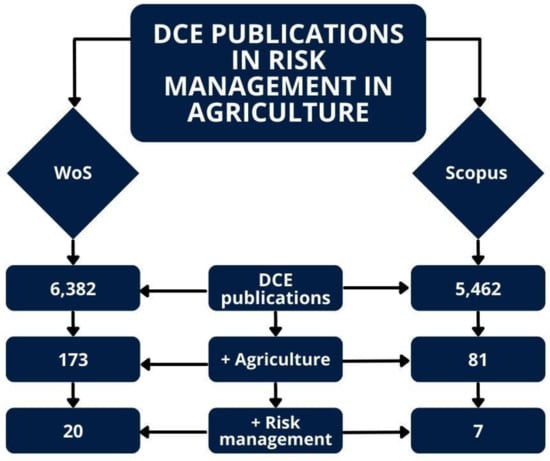
Figure 1.
Flowchart with numbers of publications found in WoS and Scopus.
During the screening step, we compared the papers that applied discrete choice experiments in risk management in agriculture (DCE-RMA). Out of 27 publications using DCE-RMA, we excluded seven publications from Scopus because they were already in the WoS database. Furthermore, we screened the titles and abstracts of 20 publications.
Finally, we excluded four publications because the publications were oriented toward urban problems and consumer preferences and did not apply the DCE approach.
In the inclusion step, we checked the 16 remaining publications and read the entirety of each publication for further review (Figure 2). A systematic literature review method is suitable for DCE-RMA publications because it is a specific research area with a small dataset.
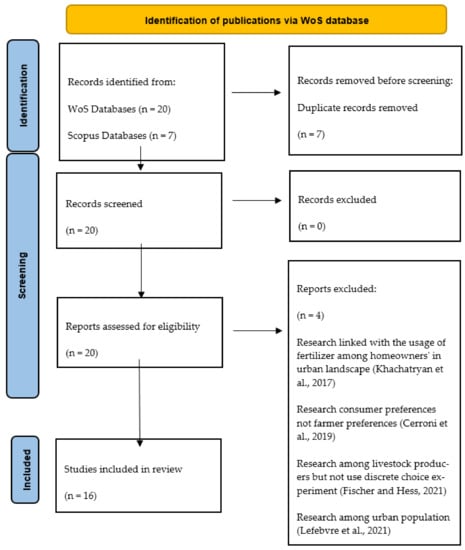
Figure 2.
Adapted PRISMA method for DCE-RMA review. Source: Khachatryan, 2017 [20]; Cerroni, 2019 [21]; Fischer and Hess, 2021 [22]; Lefebvre, 2021 [23]; and PRISMA [24].
If we compare the WoS data with the data from the Scopus database, we can conclude that in Scopus, there were 5462 publications published from 2001 to 2021, 85.60% of which were also WoS publications. If we consider the number of DCE publications in agriculture, there were 81 published papers in the Scopus database. If we narrow the scope to include DCE publications on risk management in agriculture, only seven papers were published from 2001 to 2021. All seven publications were available in the WoS database. Because of the higher share of publications in WoS, further bibliometric analysis and a systematic literature review were carried out using the publications from the WoS database.
3. Results
3.1. Discrete Choice Experiment Publications Worldwide
In the last 20 years, 6382 publications indexed in WoS have explored discrete choice experiments in different research areas. The sum of all of the DCE publications was 100,445; the average number of citations per item was 15.74; and the h-index was 112. The increase in DCE publications in all research areas can be seen in Figure 3.
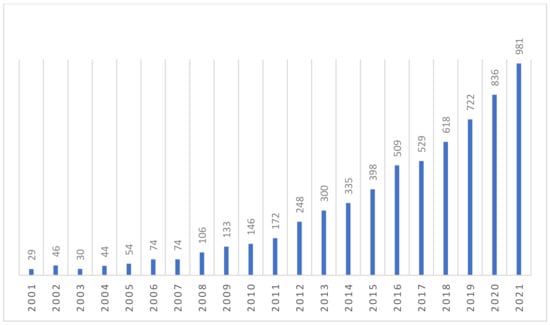
Figure 3.
The number of research publications using DCE from 2001 to 2021.
The most significant proportion of publications were in the subject areas such as business economics (43.20%), health care sciences services (32.60%), and psychology (30.27%). On the other hand, the smallest percentage of publications were in the subject areas of area studies (0.016%), literature (0.016%), and music (0.016%) (Figure 4). The subject area of agriculture was in 17th place out of the top 20 subject areas (7.04% of all DCE publications). Most of the publications were articles (83.31%), and the most of the authors conducting DCE research were from the USA (29.06% of all DCE publications) and the United Kingdom (16.14% of all DCE publications). Additionally, 49.31% of DCE research was open access, and 98.61% of publications were written in English.
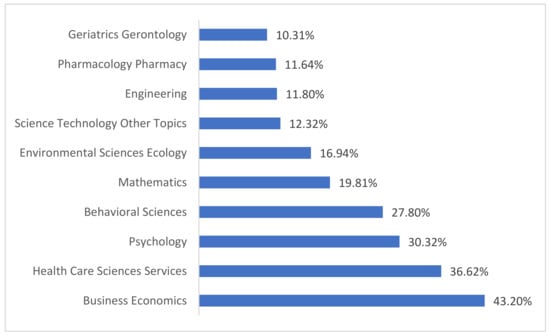
Figure 4.
Distribution of DCE research by research area (top 10).
3.2. Discrete Choice Experiment Publications in Agriculture
After adding the keyword “Agriculture”, the number of publications published in the last 20 years appeared to be 173. According to different research areas in WoS, 88.44% of the publications were in the research areas of agriculture, business economics (87.28%), environmental sciences ecology (57.83%), and food science technology (35.26%). Figure 5 shows the top 10 research areas and their percentages. In the agriculture research area, the most significant share of the publications were articles (97,69%), review articles—2.89%, and books—0.58%. Most of the publications had been published in recent years: 2019 (20.81%), 2021 (19.65%), and 2020 (12.72%). There was one publication published per year in the first ten years of the considered time period, and no papers were published in some years. However, after 2011, an increase in DCE publications in agriculture of 280% was recorded (e.g., 2011—5 publications, 2014—6 publications, 2016 and 2017—17 publication, and 2018—19). Out of all of the publications, 97.69% of the publications were written in English; 4.62% were written in French; and 4.05% were written in German. Most of the DCE in agriculture publications are from the USA (22.54%), Germany (20.81%), and Italy (8.67%).
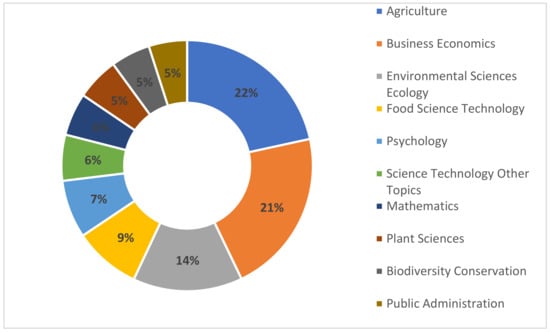
Figure 5.
DCE research in agriculture is distributed by research area (top 10).
Bibliometric analysis shows that the words “preference” and “farmer” have the most significant nodes and represent the greatest occurrence among DCE publications in agriculture (Figure 6). The thicker link between the preference–farmer node, farmer–willingness node, farmer–risk node, and risk–preference node shows the stronger link between words. Three colors (red, blue, and green) represent three thematic clusters. Clusters showed the relationship between one word and another. There is a close relationship between risk and time preference words, as well among DCE and adoption words, and other words colored in red.
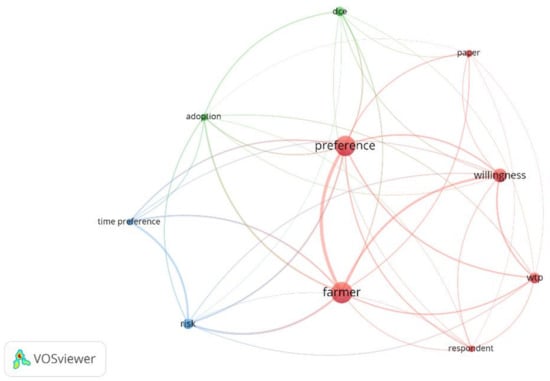
Figure 6.
Main words in DCE in agriculture publications.
3.3. Discrete Choice Experiment Publications in Risk Management in Agriculture
Further analysis shows that by narrowing the area of research and adding the keyword “risk management”, 20 papers published from 2001 to 2021 were found. From 2013 to 2021, 20 publications were cited 267 times (Figure 7); the average number of citations per item was 13.35; and the h-index was 9.
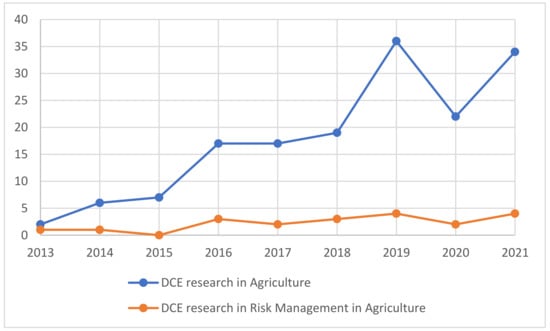
Figure 7.
Trends in DCE research in agriculture and risk management in agriculture.
The increase in DCE papers on agricultural risk management was recorded, with one paper being recorded in 2013 and four papers being recorded in 2021 (Table 1). Papers in the mentioned research area did not exist before 2013.

Table 1.
DCE in agricultural risk management publications (DCE-RMA), 2013–2021.
According to the first authors’ affiliation, publications were primarily from the USA and Germany. The main co-authors were from South Korea, China, New Zealand, Ecuador, South Africa, Malawi, Australia, France, Scotland, Spain, Ghana, Ethiopia, Canada, and Japan (Table 2). In total, 82 authors were involved in the 20 publications. The minimum number of authors was two, which increased to a maximum of nine authors per publication. In the last ten years, there were four authors per publication on average.

Table 2.
The number of papers according to authors’ affiliation country and the countries of the principal co-authors.
3.4. Risk Management in Agriculture Using DCE—Review
An analysis of the defined keywords enabled the most relevant DCE-RMA publications to be found. After applying the PRISMA approach for a systematic literature review, 16 publications were further analysed.
The main words included in the analysis of the DCE publications on risk management in agriculture were farmer, discrete choice experiment, and willingness. VOSviewer output (Figure 8) shows that the word farmer occurred in DCE-RMA publications the most, as indicated by the bigger node. The words “discrete choice experiment” and “willingness” occurred almost the same number of times. The thicker the link between three nodes of“DCE”, “willingness”, and “farmer” shows the greater occurrence between words in publications. The red color presents one thematic cluster.
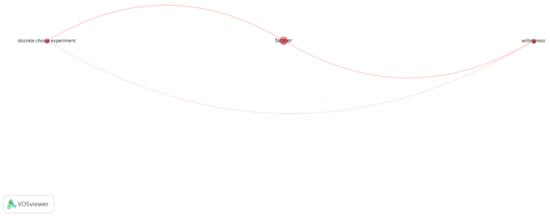
Figure 8.
Main words in DCE-RMA publications.
The publications in the agricultural risk management research area mainly focused on on-farm strategies and risk transfer strategies. However, farmers apply on-farm strategies farmers more often than risk transfer strategies. In connection with this, Crastes et al. researched the benefits of an integrated management policy that embraces good farming practices against erosive runoff events and flood protection programs among rural and urban respondents in France [25]. In addition, willingness to pay (WTP) for DCE attributes was examined.
Furthermore, Ward et al. researched farmers’ preferences for different conservation agriculture practices and their (marginal) willingness to adopt (WTA) them on their farms [26]. Specifically, the study addressed readiness to apply conservation agriculture strategies proposed by different providers (program implementers). The impact of subsidies on farmers’ choices was also researched. Face-to-face interviews among 60 villages in Malawi were conducted, and the DCE survey was integrated into a continuous standard household survey.
Farmers did not adopt conservation agriculture frequently in Ecuador, which is located in the Andean region. As such, Barrowclough et al. identified the most important attribute for farmers when adopting conservation agriculture and concluded that farmers are only willing to pay for it if they expect long-term gains [27]. Furthermore, because labour savings is the most important attribute, it can be expected that conservation agriculture will be more attractive to farmers due to its less intensive practices. Moreover, Barrowclough and Alwang researched factors that affect the possibility of adopting conservation agriculture and which factors are most important for producers [28]. Finally, Barrowclough and Alwang used willingness to pay to estimate the expected welfare changes associated with conservation agriculture adoption [28].
The motivation to grow energy crops instead of status quo production was examined by Khanna et al., who also examined how contract attributes affect choosing energy crops [29]. Marginal willingness to pay for contract attributes was analysed. Farmers ready to adopt energy crops mainly had large farms with higher debt–asset ratios and a lower annual current production income. Further research showed how insurance contracts and types of insurance impact the decision to adopt energy crops [29]. In the end, these publication results can help to design effective contracts and policies to promote the production of energy crops.
Farmers’ willingness to accept short-rotation lignocellulosic perennial crops such as coppice and miscanthus was examined in Baden–Wuerttemberg [30]. The research showed how risk attitudes, farm size, and leased land impact farmers’ choices [28]. Positive attributes such as average yearly contribution margin, long-term purchase guarantees, and cultivation improved willingness to accept the production of these crops, while attributes such as contribution margin variability and initial investment had a negative impact on the willingness to adopt both crops. Four supply functions were defined according to different combinations of initial investment and the purchase guarantee prospect (or unavailability). Farmers’ willingness to adopt sustainability schemes on their farms was researched by Hannus et al. [31]. Farmer attitude, risk perception, age, and education were additionally explored to examine the impact on choosing sustainability schemes.
DCE research assessed agricultural stakeholders’ willingness to pay for biodegradable plastic mulches instead of polyethylene mulches in the farm supply chain [32]. Willingness to pay among different attributes was researched using DCE. Moreover, risk preferences, socio-demographics, farm characteristics, and previous experience with polyethylene mulches and biodegradable plastic mulches influenced the respondents’ readiness to choose biodegradable plastic mulches.
Besides adopting production technology strategies, Fecke et al. researched German farmers’ willingness to accept e-commerce (online shopping) when buying crop protection products [33]. Farmers will only accept online shopping from local shops if online merchants provide discounts. Delivery times (short) influence farmers’ willingness to accept online and local merchants. Prior online buying experience and the buyer having a higher educational level do not impact whether or not they will make a future online purchase. On the other hand, the researchers concluded that if a farmer is more risk-averse, the higher their willingness to accept an online purchase is.
Few DCE papers discussed risk transfer strategies. As mentioned, Mollmann et al. studied farmers’ acceptance of subsidized whole-farm income insurance and revenue insurance in the situation of reduced direct payments and their willingness to pay for both types of insurance [34]. Farmers are more willing to pay for subsidized whole farm income insurance than revenue insurance. Additionally, analysis shows that coverage level and public insurance positively influence the willingness to pay. Are farmers willing to choose crop insurance? Additionally, how risk, ambiguity aversion, and liquidity impact choice were researched using field experiments by Ali et al. [35].
Farmers are increasingly facing the effects of climate change and uncertain weather events. Farmers’ readiness to implement climate change policies to account for different future weather events (e.g., floods) was researched in Autria by Probstl-Haider et al. [36]. An online questionnaire was prepared and distributed to farmers during meetings in the study areas, and farmers were guided in cooperation with the representatives of the Chamber of Agriculture. Drought risks represent the most significant threat for farmers, especially in India [37]. Farmers’ preferences and willingness to pay for drought-tolerant rice and weather index insurance strategies to cope with drought were examined. Ortega et al. researched how to manage and mitigate drought risk in Bangladesh [38]. Furuya et al. researched farmers’ readiness to apply weather index insurance to mitigate the effects of climate change [39].
Smallholders’ motivation to participate in contract farming was researched by Abebe et al. [40]. The research examined the preferences of farmer from developing countries with regard to contract farming. Six attributes defined contract farming between the farmers and buying firms. The results showed that farmers are more ready to participate in contract farming if it is designed as follows: the contract is presented in a written form; input uncertainty is higher than output uncertainty; technical assistance is provided by the government rather than by NGOs; and technical assistance and seeds are supplied by the buyer firm. In addition, the farmers preferred variable output quality, with varying price options indicating that these farmers were more risk taker compared to results that showing that farmers on average tend to be more risk averse. Abebe et al. contributed to the literature by improving current and future contract farming schemes [40].
A short overview of the DCE publications applying risk management in agriculture can be found in Table 3.

Table 3.
Short review of risk management in agriculture using DCE.
Furthermore, Figure 9 shows co-authorship analysis for 16 DCE-RMA publications, indicating the authors’ contributions to the research field. Networks among authors-co-authors were visualized using VoSviewer software.
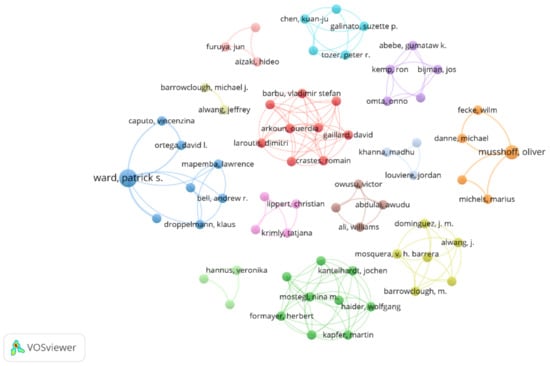
Figure 9.
Authors’ Contributions to DCE-RMA.
After conducting the presented review research, it can be concluded that DCE research on risk management in agriculture is primarily applicable for researching on-farm and risk transfer strategies at the farm level.
DCE-RMA publications have experienced a growing trend from 2013 to 2021. Publications in the DCE-RMA research area did not exist before 2013. After 2013, the development of DCE-RMA research becomes noticeable. A larger share of the research explored on-farm strategies and farmers’ preferences according to conservation agriculture. The DCE method further explored producing energy crops and switching to online shopping. Which type of insurance and how to design insurance according to farmers’ preferences were studied. The authors used the willingness to pay measure to further research the respondents’ readiness to pay more for every attribute defined in the research.
The first research from 2013 was in the area of contract farming, and research then evolved to the implementation of new production technology and concerns about climate change. In 2018 and 2019, the main research area was still production technology, and the emphasis was on drought risk and online market channels. Weather index insurance as the focus of DCE publications occurred for the first time in 2018, and this research direction continued in 2019, considering different types of agricultural insurance. From 2020, sustainability issues became more critical. In 2021, the main research areas were risk transfer strategies, crop insurance, and weather index insurance.
It can be concluded that all of the publications are primary research. However, in the observed period, theoretical and review papers researching the applicability of DCE for risk management in agriculture do not exist. To cover this gap, this paper aimed to review DCE publications on agricultural risk management spanning two decades using bibliometric analysis and a systemic literature review. Another advantage of the work is that it is a review of the dynamics of DCE publications in general and on agriculture over the last 20 years.
According to the researched publications, the sample size in DCE research among farmers ranges from a minimum of 64 to a maximum of 2306. On average, studies have 640 respondents. Only one publication targeted farmers, crop advisors, educators, and other stakeholders in agriculture [32]. All of the other publications were directed at farmers only. Of the research that uses DCE among farmers, 43% is conducted in Europe. Most of the research covers farmers from Asia and Africa, and two publications are from the US. There are no restrictions on the number of attributes included in a DCE [6,7,41]. However, it is suggested to use less than ten attributes; in the reviewed publications, there were four to five attributes on average.
4. Conclusions
This review has attempted to summarize recent publications on agricultural risk management that use discrete choice experiments as a hypothetical approach for eliciting stated preferences. To the best of our knowledge, there has been no detailed investigation of publications that apply a discrete choice experiment approach to study risk management in agriculture. Therefore, bibliometric analysis was used for DCE publications to research the dynamics in DCE in general, in agriculture, and specifically DCE-RMA from 2001 to 2021. The increase in publications and the importance of the DCE method were recorded. From the systematic literature review of the DCE-RMA publications, it can be noted that a large part of the publications researched conservation agriculture, the possibility of introducing management policies on farms, production of the new crops on farms, readiness for e-commerce, and readiness for different types of agricultural insurance, such as crop insurance, revenue insurance, whole-farm income, and weather index insurance. In addition, the publications cover larger-scale on-farm strategies. A list of the attributes used in the publications is available in Table 3; on average, four to five attributes were used per publication.
However, all of the researched publications are primary research, and a literature review study that investigates the discrete choice experiment approach for agricultural risk management does not exist. This paper fills the mentioned gap using bibliometric analysis and the PRISMA method to conduct a systematic literature review of DCE publications on risk management in agriculture. The review study refers to the period 2001 to 2021.
With the increase in DCE research over the last twenty years, we can conclude that the mentioned research will continue to be an important area of study for agricultural economists and scientists because they need to play a leading role in testing and designing strategies, rural development policies, and products as well as risk management toolkits according to the Common Agricultural Policy. DCE contributes to testing strategies, rural development policies, and products before implementation.
The limitations of this research can be defined by the keywords of the authors’ interest and what the authors wanted to contribute to the area of risk management in agriculture, as well as the study period.
Though there is a relatively small amount of DCE-RMA, increasing it opens a new method for further publications on risk management and farm management. Indeed, future DCE research could elicit farmers’ preferences for different risk management strategies, focusing on innovative Common Agricultural Policy strategies and measures. For example, farmers’ readiness to accept new innovative risk management strategies (such as mutual funds and income stabilization tool schemes) and their willingness to pay for the mentioned strategies. The DCE approach would help policy makers to design the best mutual fund according to the farmers’ requirements.
Author Contributions
Conceptualization, T.Č. and M.Nj.; methodology, T.Č.; validation, T.Č.; formal analysis, T.Č.; writing—original draft preparation, T.Č.; writing—review and editing, M.Nj. All authors have read and agreed to the published version of the manuscript.
Funding
This research received no external funding.
Institutional Review Board Statement
Not applicable.
Informed Consent Statement
Not applicable.
Data Availability Statement
Not applicable.
Conflicts of Interest
The authors declare no conflict of interest.
References
- Doyon, M.; Rondeau, D.; Mbala, R. Keep it down: An experimental test of the truncated k-double auction. Agric. Resour. Econ. Rev. 2010, 39, 193–212. [Google Scholar] [CrossRef]
- Mesa-Vázquez, E.; Velasco-Muñoz, J.F.; Aznar-Sánchez, J.A.; López-Felices, B. Experimental Economics in Agriculture: A Review of Worldwide Research. Agronomy 2021, 11, 1566. [Google Scholar] [CrossRef]
- Schubert, C. Green nudges: Do they work? Are they ethical? Ecol. Econ. 2017, 132, 329–342. [Google Scholar] [CrossRef]
- Patterson, W.; Winston-Proctor, C.E. Behavioral Cybersecurity: Applications of Personality Psychology and Computer Science; CRC Press: Boca Raton, FL, USA; Taylor and Francis Group: Abingdon, UK, 2019. [Google Scholar]
- Thoyer, S.; Préget, R. Enriching the CAP evaluation toolbox with experimental approaches: Introduction to the special issue. Eur. Rev. Agric. Econ. 2019, 46, 347–366. [Google Scholar] [CrossRef]
- Mangham, L.J.; Hanson, K.; McPake, B. How to do (or not to do) … Designing a discrete choice experiment for application in a low-income country. Health Policy Plan. 2009, 24, 151–158. [Google Scholar] [CrossRef]
- Train, K.E. Discrete Choice Methods with Simulation, 2nd ed.; University Press: Cambridge, UK, 2009. [Google Scholar]
- Njavro, M.; Čop, T. Upravljanje Rizikom u Poljoprivredi; Fakultetski priručnik; Mate d.o.o.: Zagreb, Croatia, 2021. [Google Scholar]
- Čop, T.; Njavro, M. Risk management of Dalmatian grape and wine producers facing climate change. J. Cent. Eur. Agric. 2022, 23, 232–245. [Google Scholar] [CrossRef]
- Smrkulj, H.; Njavro, M. Risk Management on the Winegrowing Farms at Northwest Croatia. J. Cent. Eur. Agric. 2016, 17, 221–235. [Google Scholar] [CrossRef]
- Gugić, J.; Par, V.; Njavro, M.; Verović, A. Izvori rizika i strategije upravljanja rizikom na vinogradarsko-vinarskim gospodarstvima u Dalmaciji. Agron. Glas. 2008, 70, 425–438. [Google Scholar]
- Njavro, M.; Par, V.; Pleško, D. Livestock Insurance as a Risk Management Tool on Dairy Farms. Poljoprivreda 2007, 13, 78–82. [Google Scholar]
- Njavro, M.; Jakobović, S.; Budimir, V. Upravljanje rizikom na voćarskim i vinogradarsko-vinarskim gospodarstvima Slavonije i Baranje. Poljoprivreda 2005, 11, 31–37. [Google Scholar]
- Donthu, N.; Kumar, S.; Mukherjee, D.; Pandey, N.; Lim, W.M. How to conduct a bibliometric analysis: An overview and guidelines. J. Bus. Res. 2021, 133, 285–296. [Google Scholar] [CrossRef]
- VOSviewer Software. Available online: https://www.vosviewer.com/ (accessed on 22 July 2022).
- Raina, N.; Zavalloni, M.; Targetti, S.; D’Alberto, R.; Raggi, M.; Viaggi, D. A systematic review of attributes used in choice experiments for agri-environmental contracts. Bio-Based Appl. Econ. 2021, 10, 137–152. [Google Scholar] [CrossRef]
- Moher, D.; Liberati, A.; Tetzlaff, J.; Altman, D.G. Preferred reporting items for systematic reviews and meta-analyses: The PRISMA statement. Int. J. Surg. 2010, 8, 336–341. [Google Scholar] [CrossRef] [Green Version]
- Web of Science. Available online: https://www.webofscience.com/wos/alldb/basic-search (accessed on 11 May 2022).
- Scopus. Available online: https://www.scopus.com/search/form.uri?display=basic#basic (accessed on 11 May 2022).
- Khachatryan, H.; Suh, D.H.; Zhou, G.; Dukes, M. Sustainable urban landscaping: Consumer preferences and willingness to pay for turfgrass fertilizers. Can. J. Agric. Econ./Rev. Can. D’agroeconomie 2017, 65, 385–407. [Google Scholar] [CrossRef]
- Cerroni, S.; Watson, V.; Kalentakis, D.; Macdiarmid, J.I. Value-elicitation and value-formation properties of discrete choice experiment and experimental auctions. Eur. Rev. Agric. Econ. 2019, 46, 3–27. [Google Scholar] [CrossRef]
- Fischer, K.; Hess, S. Beyond Cost Minimisation: Farmers’ Perspectives on the Adoption of GM Fodder in Sweden. Ger. J. Agric. Econ. 2021, 70, 84–100. [Google Scholar] [CrossRef]
- Lefebvre, M.; Maslianskaïa-Pautrel, M.; Laïlle, P. Individual preferences for pesticide-free management of urban green spaces: The French example. Rev. Econ. 2021, 72, 947–967. [Google Scholar]
- PRISMA. Available online: http://www.prisma-statement.org/Default.aspx (accessed on 11 May 2022).
- Crastes, R.; Beaumais, O.; Arkoun, O.; Laroutis, D.; Mahieu, P.A.; Rulleau, B.; Hassani-Taibi, S.; Barbu, V.S.; Gaillard, D. Erosive runoff events in the European Union: Using discrete choice experiment to assess the benefits of integrated management policies when preferences are heterogeneous. Ecol. Econ. 2014, 102, 105–112. [Google Scholar] [CrossRef]
- Ward, P.S.; Bell, A.R.; Parkhurst, G.M.; Droppelmann, K.; Mapemba, L. Heterogeneous preferences and the effects of incentives in promoting conservation agriculture in Malawi. Agric. Ecosyst. Environ. 2016, 222, 67–79. [Google Scholar] [CrossRef]
- Barrowclough, M.; Stehouwer, R.; Alwang, J.; Gallagher, R.; Mosquera, V.B.; Dominguez, J.M. Conservation agriculture on steep slopes in the Andes: Promise and obstacles. J. Soil Water Conserv. 2016, 71, 91–102. [Google Scholar] [CrossRef]
- Barrowclough, M.J.; Alwang, J. Conservation agriculture in Ecuador’s highlands: A discrete choice experiment. Environ. Dev. Sustain. 2018, 20, 2681–2705. [Google Scholar] [CrossRef]
- Khanna, M.; Louviere, J.; Yang, X. Motivations to grow energy crops: The role of crop and contract attributes. Agric. Econ. 2017, 48, 263–277. [Google Scholar] [CrossRef]
- Gillich, C.; Narjes, M.; Krimly, T.; Lippert, C. Combining choice modeling estimates and stochastic simulations to assess the potential of new crops—The case of lignocellulosic perennials in Southwestern Germany. GCB Bioenergy 2019, 11, 289–303. [Google Scholar] [CrossRef]
- Hannus, V.; Venus, T.J.; Sauer, J. Acceptance of sustainability standards by farmers-empirical evidence from Germany. J. Environ. Manag. 2020, 267, 110617. [Google Scholar] [CrossRef]
- Chen, K.J.; Galinato, S.P.; Marsh, T.L.; Tozer, P.R.; Chouinard, H.H. Willingness to Pay for Attributes of Biodegradable Plastic Mulches in the Agricultural Sector. HortTechnology 2020, 30, 437–447. [Google Scholar] [CrossRef]
- Fecke, W.; Danne, M.; Musshoff, O. E-commerce in agriculture–The case of crop protection product purchases in a discrete choice experiment. Comput. Electron. Agric. 2018, 151, 126–135. [Google Scholar] [CrossRef]
- Möllmann, J.; Michels, M.; Musshoff, O. German farmers’ acceptance of subsidized insurance associated with reduced direct payments. Agric. Financ. Rev. 2019, 79, 408–424. [Google Scholar] [CrossRef]
- Ali, W.; Abdulai, A.; Goetz, R.; Owusu, V. Risk, ambiguity and willingness to participate in crop insurance programs: Evidence from a field experiment. Aust. J. Agric. Resour. Econ. 2021, 65, 679–703. [Google Scholar] [CrossRef]
- Pröbstl-Haider, U.; Mostegl, N.M.; Kelemen-Finan, J.; Haider, W.; Formayer, H.; Kantelhardt, J.; Moser, T.; Kapfer, M.; Trenholm, R. Farmers’ preferences for future agricultural land use under the consideration of climate change. Environ. Manag. 2016, 58, 446–464. [Google Scholar] [CrossRef]
- Ward, P.S.; Makhija, S. New modalities for managing drought risk in rainfed agriculture: Evidence from a discrete choice experiment in Odisha, India. World Dev. 2018, 107, 163–175. [Google Scholar] [CrossRef] [PubMed]
- Ortega, D.L.; Ward, P.S.; Caputo, V. Evaluating producer preferences and information processing strategies for drought risk management tools in Bangladesh. World Dev. Perspect. 2019, 15, 100132. [Google Scholar] [CrossRef] [PubMed]
- Furuya, J.; Omori, K.; Aizaki, H. Toward the development of a weather index insurance for rice farmers in the coastal region of Myanmar. Paddy Water Environ. 2021, 19, 255–260. [Google Scholar] [CrossRef]
- Abebe, G.K.; Bijman, J.; Kemp, R.; Omta, O.; Tsegaye, A. Contract farming configuration: Smallholders’ preferences for contract design attributes. Food Policy 2013, 40, 14–24. [Google Scholar] [CrossRef]
- De Shazo, J.R.; Fermo, G. Designing choice sets for stated preference methods: The effects of complexity on choice consistency. J. Environ. Econ. Manag. 2002, 44, 123–143. [Google Scholar] [CrossRef]
Publisher’s Note: MDPI stays neutral with regard to jurisdictional claims in published maps and institutional affiliations. |
© 2022 by the authors. Licensee MDPI, Basel, Switzerland. This article is an open access article distributed under the terms and conditions of the Creative Commons Attribution (CC BY) license (https://creativecommons.org/licenses/by/4.0/).